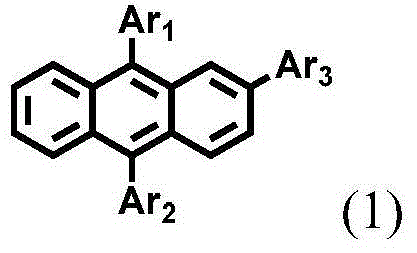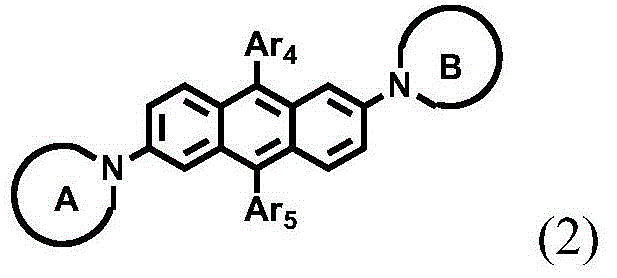Organic Electroluminescent Device
An electroluminescent device, organic technology, applied in the direction of electric solid devices, electrical components, luminescent materials, etc., can solve the problem of undisclosed organic electroluminescent devices, etc., and achieve the effects of improved lifespan, improved power efficiency, and low driving voltage
- Summary
- Abstract
- Description
- Claims
- Application Information
AI Technical Summary
Problems solved by technology
Method used
Image
Examples
Embodiment 1
[0086] Embodiment 1: the preparation of compound H-33
[0087]
[0088] Preparation of compound 1-1
[0089] After adding 2-bromonaphthalene (819 g, 3.96 mol) to tetrahydrofuran (THF) (5 L), the mixture was stirred at room temperature for 10 minutes to completely dissolve 2-bromonaphthalene, followed by cooling to -72°C. To this mixture was slowly added n-butyllithium (1.6M in n-hexane) (2.68 L, 4.285 mol) dropwise. After 1 hour, 2-chloroanthraquinone (400 g, 1.648 mol) was added to the mixture, and then the mixture was stirred for 26 hours while slowly warming to room temperature. After addition of saturated ammonium chloride solution, the mixture was stirred for 1 hour and then filtered under reduced pressure. The separated organic layer was evaporated to obtain compound 1-1 (brown solid, 551 g, 67%).
[0090] Preparation of compound 1-2
[0091] Compound 1-1 (551g, 1.104mol), potassium iodide (733g, 4.42mol), sodium dihydrogenphosphate monohydrate (NaH 2 PO 2 ...
Embodiment 2
[0096] Embodiment 2: the preparation of compound D-7
[0097]
[0098] Preparation of compound 2-1
[0099] After dissolving 2-bromofluorene (74 g, 270.7 mmol) in anhydrous tetrahydrofuran solvent (500 mL), 2.5 M n-butyllithium (2.5 M in hexane) was slowly added dropwise to the mixture at -78 °C ( 130.0 mL, 324.9 mmol). After stirring for 1 hour, 2,6-dibromoanthracene-9,10-dione (30.0 g, 108.3 mmol) was added to the mixture. The mixture was stirred while warming slowly to room temperature. After 17 hours, water was added to the mixture. The mixture was stirred for 30 minutes, extracted with ethyl acetate (EA) (500 mL), and washed with water (500 mL). Magnesium sulfate was added to the obtained organic layer to remove water. The obtained substance was distilled under reduced pressure and dried to obtain compound 2-1 (150.8 g, 200 mmol).
[0100] Preparation of compound 2-2
[0101] After dissolving compound 2-1 (11 g, 14.51 mmol), potassium iodate (KI) (9.64 g, ...
PUM
| Property | Measurement | Unit |
|---|---|---|
| Thickness | aaaaa | aaaaa |
| Current density | aaaaa | aaaaa |
Abstract
Description
Claims
Application Information
 Login to View More
Login to View More - Generate Ideas
- Intellectual Property
- Life Sciences
- Materials
- Tech Scout
- Unparalleled Data Quality
- Higher Quality Content
- 60% Fewer Hallucinations
Browse by: Latest US Patents, China's latest patents, Technical Efficacy Thesaurus, Application Domain, Technology Topic, Popular Technical Reports.
© 2025 PatSnap. All rights reserved.Legal|Privacy policy|Modern Slavery Act Transparency Statement|Sitemap|About US| Contact US: help@patsnap.com



